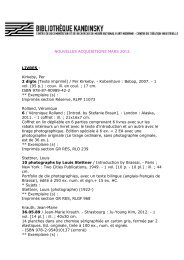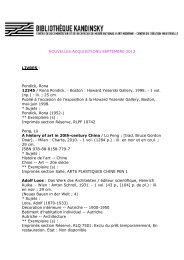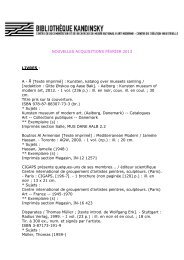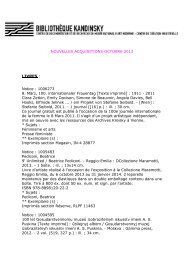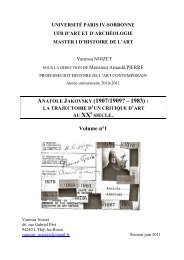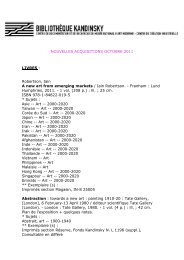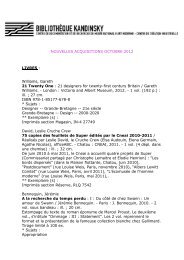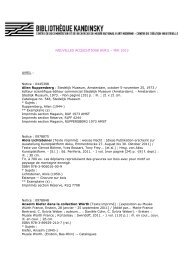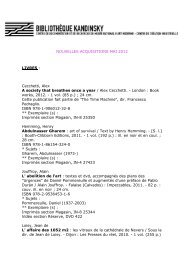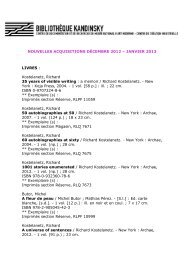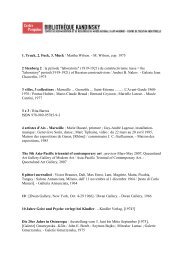anatole jakovsky (1907/1909 ? â 1983) - Bibliothèque Kandinsky
anatole jakovsky (1907/1909 ? â 1983) - Bibliothèque Kandinsky
anatole jakovsky (1907/1909 ? â 1983) - Bibliothèque Kandinsky
Create successful ePaper yourself
Turn your PDF publications into a flip-book with our unique Google optimized e-Paper software.
La trajectoire d’un critique d’art au XXe siècle.<br />
A vast landscape open to every delight and every wind – cleared lands, yellow, red and<br />
green, rising to meet the assault of the sky and its lights – such is the image of the old Russia<br />
which can be read in the first pictures of <strong>Kandinsky</strong>.<br />
From the first his genius anticipates and foretells the destiny of our civilisation, the<br />
clash of two worlds, which is to happen later. Of two lives rather, before and after the fait<br />
accompli of the industrial revolution, representing those two antagonistic forces which<br />
determined the appearance of the phenomenon of «Modern Art».<br />
The large town with its factories invades the countryside, abruptly changins its aspect,<br />
its psychology, its vision. A whole gamut of colours which once graced peasant-work, work<br />
made with human hands, so lyrical, so individual and unique, is from this moment condemned<br />
to disappear, menaced by the mass-produced article. And this persistent inertia, this legendary<br />
«firebird» which nests and finds a home in every toy of this country, prostrates its gorgeous<br />
wings, ready to fly away for ever.<br />
On the aesthetic plane this conflict manifests itself from the very first in the agony of<br />
the conception of landscape – in the extra-subjective deformation of that which used to be<br />
looked on as unchangeable, through the window of Corot’s eternal Sunday. His idyllic, and<br />
above all static, Open air symbolised the well-being of the society in which he lived ; of the<br />
well-ripened society which approaches the beginning of its own decadence. This last begins<br />
with Impressionism – with the transitional style which has merely undermined the old beauty<br />
without putting another in its place. They, the townsmen, open-air tourists, no longer come<br />
except to glance at its ruins. In fact, the landscape conception is decaying everywhere ;<br />
following different rhythms and speeds and thus representing very different ideologies.<br />
<strong>Kandinsky</strong>’s landscape exalts the solar eruption.<br />
German expressionism which he engenders later, and which borrows from <strong>Kandinsky</strong><br />
the form and not the content, is to exalt the eartquake shocks of the small towns ; their pale,<br />
convulsive, colourless population thrown at random into a life which begins at midnight.<br />
French «fauvism», on the other hand, is to transform the landscape more lengthily,<br />
more slowly, bringing it at last to an arabesque (Matisse) to a painted paper – nature at home<br />
– nature morte. The logical outcome, moreover, of this art which only considers the object<br />
and what is left to the object. Italian futurism begins otherwise, more directly. By the blind<br />
apotheosis of the machine and industry. But neither that nor German expressionism have had<br />
time to create a stable and durable art, which demands either a slow tradition or the powerful<br />
biological force of an ascendant race.<br />
77



